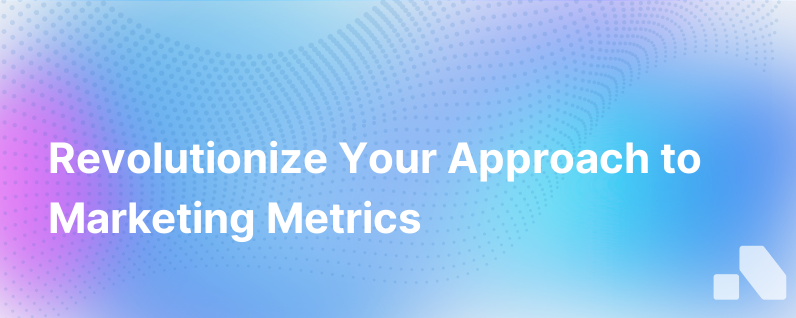Rethinking Your Marketing Metrics
Published on October 13, 2023 by Sawyer Middeleer
In the rapidly-evolving digital landscape, marketers are often swamped with data. With advancements in tracking technologies and analytics platforms, it's easy for a marketer to get lost in vanity metrics that might look impressive on paper but don't necessarily contribute to the bottom line. It's crucial for marketers to differentiate between the numbers that truly matter and the ones that are mere noise. But in an industry often obsessed with clicks and views, what does it take to rethink your marketing metrics effectively?
Let's dive into the world of marketing analytics and explore how to tailor an ideal metric system that aligns closely with your business goals.
Scrutinizing Standard Marketing Metrics
Traditional metrics like page views, session length, and bounce rate have ruled the marketing world for years. They provide a surface-level understanding of how audiences are interacting with your brand online. But do they tell us everything we need to know about the impact of marketing efforts on sales growth or customer loyalty? Not really. Here lies the gap that needs bridging.
Vanity vs. Value
The first step in rethinking your marketing metrics is distinguishing 'vanity' metrics from 'value' metrics. Vanity metrics are often misleading because they showcase growth but don’t correlate directly to the parameters that truly signify business success, such as revenue generation, cost reduction, or customer satisfaction.
Conversely, value metrics are grounded in the business's economic model. They provide actionable insights that can aid in optimizing marketing strategies for better ROI. Shifting focus from vanity to value metrics compels you to center your analysis on economic outcomes rather than just consumption behavior.
'Conversions' as a Central Pillar
The ultimate aim of any marketing effort is action, not just awareness. While reach and impressions are important for understanding scale, conversions stand as pillars displaying the effectiveness of campaigns in terms of engagement and customer acquisition.
Conversion rates, customer acquisition costs, and customer lifetime value metrics paint a more precise picture of a marketing campaign's success and provide actionable intelligence for future strategic decisions.
The North Star Metric
In your quest for analytical clarity, identifying a 'North Star' metric can align teams around a singular focus that propels business growth. This critical metric should closely reflect customer value and company's success. For a subscription service, this could be the monthly recurring revenue (MRR), whereas for an e-commerce platform, it might be the average order value (AOV) or repeat purchase rate.
Holistic Measurement: Beyond the Clicks
As you transition from conventional metrics, consider adopting a more holistic approach to measurement. This includes:
- Attribution modelling: Understanding the customer journey across different touchpoints is essential. A multitouch attribution model will give you a nuanced view of how various channels contribute to the final conversion, allowing you to allocate your marketing budget more effectively.
- Sentiment analysis: It's one thing to see that your content is being shared; it's another to understand how people feel about it. Incorporating sentiment analysis into your metrics toolkit can shed light on brand perception and provide guidance for messaging and positioning.
- Engagement quality: Assess not just whether consumers are engaging with your content but how they are engaging with it. Metrics like scroll depth, comments, shares, and time spent on interactive elements can offer insights into the quality of engagement.
- Customer feedback: Regular feedback through surveys and customer interviews can lead to qualitative data that may indicate where your marketing resonates and where it needs adjustment.
Leveraging Technology for Refined Metrics
To keep up with these refined metrics, marketers need to leverage advancements in analytics and AI. Platforms like Google Analytics, HubSpot, and Adobe Analytics offer advanced features that enable more detailed tracking and analysis of user behavior.
Technologies like machine learning can now predict customer behavior, calculate the potential lifetime value of segments, and anticipate churn rates with increasing accuracy. This predictive power transforms data into foresight, allowing proactive tweaks rather than reactive fixes.
Data Storytelling
Numbers need narrative. Data storytelling is about framing your findings in a context that resonates with your audience - be it the C-suite, stakeholders, or clients. It's about linking the dots to craft a tale that not only informs but also inspires action.
By embedding data into a story with clear challenges, actions, and outcomes, it sticks better and can persuade decision-makers, especially when advocating for new strategies or budget allocations.
A Culture of Continuous Optimization
Metrics are not just about reporting; they are about continuous improvement. A culture of testing, learning, and refining must be fostered, where every marketing effort is seen as an experiment with measurable hypotheses.
Regular A/B split testing, controlled experiments, and feedback loops should inform your marketing practices. This culture not only improves current campaigns but also drives innovation for future ones.
Conclusion
Rethinking your marketing metrics is not merely an operational change, it's a paradigm shift — one that involves redefining success, embracing technology, and instilling a culture of curiosity and persistent optimization. In making this shift, marketers will not just validate their contributions more meaningfully but will also propel their brands toward more impactful, data-driven storytelling and strategy. It’s about connecting the dots in a way that transcends mere tracking and taps into strategic insights that can help pave the way for sustained growth and customer engagement.